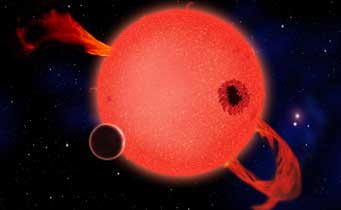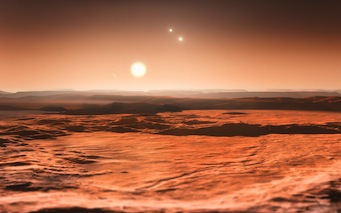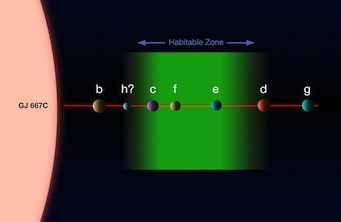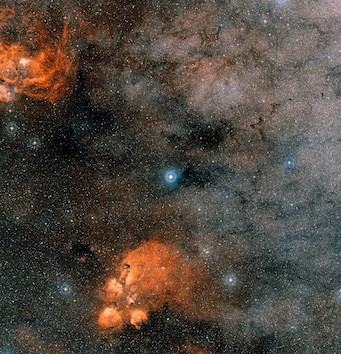Two new studies highlight the growing importance of red dwarfs in the competitive search for alien worlds — and the challenges we face in finding them.

When it's young, a red dwarf star frequently erupts with strong ultraviolet flares as shown in this artist's conception. The flares might make habitability a problem, but the planet's atmosphere could protect the surface. When the star ages and settles down, its planet would enjoy billions of years of quiet, steady radiance.
David A. Aguilar / CfA
In the search for habitable worlds teeming with alien life, many astronomers are directing their gaze to the cool, small stars known as M dwarfs. Their diminutive (and dim) nature makes it easier to find planets — especially habitable ones, which must nestle close to these red dwarfs in order to stay warm enough for liquid surface water to exist. The dwarfs’ dimness also makes it easier to pick out the spectral signatures of transiting planets’ atmospheres, which astronomers hope to exploit to search for biosignatures, chemical signs of life like oxygen.
But these stars also have a violent youthful phase of magnetic outbursts and flares, during which they would bombard close-in planets with ultraviolet and X-ray radiation, perhaps leaving their planets sterile for billions of years. This torrid history leaves astronomers wrestling with a so-what question: even if we do find these planets, are they actually habitable?
A System Packed With Planets

An artist's rendition of planet Gliese 667C d as a rocky super-Earth (although it could be gaseous instead). Its two companion stars are visible above and to the right of Gliese 667C, as well as one of the newly-discovered planets on the left, Gliese 667 e, barely visible in crescent phase.
ESO/M. Kornmesser
At half the mass of the Sun or less, M dwarfs are more susceptible to being gravitationally yanked around by their planets, making the resulting redshifts and blueshifts of their starlight more obvious. Two teams of astronomers have used this star-wobble method to identify one of the most promising systems for life: the M dwarf Gliese 667 C, the faintest star in a triple system only 22 light-years away in the constellation Scorpius. In a string of papers over the last two years, a team using the HARPS spectrograph on the European Southern Observatory’s 3.6-meter telescope in Chile has traded planet detections tit-for-tat with a second team, which combined the first’s public data with observations from less precise instruments on the Magellan and Keck telescopes. Altogether, the two teams had found two planet candidates (one in the habitable zone) and a tentative third.
This week, the second team, led by Guillem Anglada-Escudé (University of Göttingen, Germany), announced it has reanalyzed data newly released by the HARPS team and found evidence of a total of six (maybe even seven) planets — including an unprecedented three in the habitable zone. This would make GJ 667 C’s habitable zone full up, or “dynamically packed,” meaning adding more planets would destabilize the orbits of the worlds already there. The six potential planets, labeled with letters b through g, all lie within 0.6 Earth-Sun distances from their star.

A diagram of the planet candidates Anglada-Escudé's team have detected around GJ 667 C. Three of them lie in the habitable zone. The sizes of the planets and its host star are to scale, but their separations have been compressed for the diagram.
ESO
The habitable zone of GJ 667 C lies roughly from 0.1 to 0.25 AU, closer than Mercury is to the Sun. Planets e and f are the newcomers in the habitable zone; the other, planet c, had already been detected by both teams. In order from the star they are c, f, and e.
Based on how much the star appears to wobble towards and away from us, the planets could weigh as little as a few Earths, which would make them rocky, potentially habitable super-Earths. However, if the system’s orbital plane is tilted to our line of sight, astronomers aren’t seeing the planets’ full effect, meaning the worlds could be even bigger and gaseous, more like Neptune — in other words, not habitable. Which is it? “Unfortunately, we cannot even make this rudimentary evaluation based on available data and theory,” the team says in its paper.
Slow Down the Bandwagon

The three-star system of GJ 667 sits at the center of this image (although none of the components can be separated at this resolution). Two star formation regions glow bright orange in the background — NGC 6357 (upper left) and NGC 6334, The Cat’s Paw Nebula (at bottom).
ESO/Digitized Sky Survey 2 / Davide De Martin
Let’s be clear, just as Anglada-Escudé’s team is in its paper (and in their other high-profile discoveries, such as the Tau Ceti planets claim): even if they are rocky, none of these six is a confirmed planet — they are all planet candidates. (We can consider that possible seventh signal to be a planet candidate candidate.) These signals must be independently verified by another method, such as detecting the planets crossing in front of their star.
“The search is now focused on assessing if [planet b] transits,” Anglada-Escudé says, because it’s the closest to the star and most likely to do so. Since Kepler has found that the worlds in most multi-planet systems lie in a single plane like those of our solar system, if GJ 667C b transits, its brethren are much more likely to as well, he says. If they do, it would also allow the team to measure their radii. Combined with their masses, that would reveal their densities — and perhaps distinguish whether they’re rocky or gaseous.
Until confirmed, the planet candidates will come under scrutiny from other astronomers — including members of the original HARPS team. Although proud of their instrument’s performance, some are skeptical of the analysis techniques. One way Anglada-Escudé’s team uncovered the signal was by generating models of the GJ 667 C system, populating it with simulated planets to see if the data supported them. “The problem with this approach, although mathematically correct, is that it leads to a larger number of ‘false positives,’” said Francesco Pepe (Geneva Observatory), the project manager of the construction of HARPS. “If the Kepler data had been analyzed with similar criteria we would probably have thousands of false positives in the results.”
Both teams are right on the bleeding edge of current capabilities. Pepe knows HARPS as well as anybody, and coauthored the study announcing its detection last year of Alpha Centauri Bb — but he cautions that, too, is not 100% confirmed and has recently come into dispute.
Anglada-Escudé says his team is confident the detections are robust: GJ 667 C is an old star (at least 2 billion years) and is less magnetically active, making it easier to sort the planetary signals in the data from the stellar noise. Because of this, he adds, “there is no reason to assume that life could not form after an early phase of strong stellar activity.”
But Is It Habitable?
But just because they have the right temperature for water doesn’t mean these planet candidates would have environments that can sustain life. The question of true habitability “requires the attention of many scientific communities,” says researcher Aline Vidotto (University of St Andrews, UK). One piece of that puzzle is a planet’s magnetic field, its interplanetary shield against the onslaught of radiation from its host star. Is the extent of its protection (called a magnetosphere) large enough to shelter life from the flux of an M dwarf, especially in its turbulent adolescent phase?
Earth’s magnetosphere goes out to roughly 12 times Earth’s radius. A shield smaller than that could expose the planet’s atmosphere to erosion by the stellar wind, Vidotto and her colleagues noted in a study posted last week to the online arXiv preprint repository. It would help a planet to be further away from its star, where the pressure of the stellar wind is weaker and the planet’s magnetosphere could swell without impediment.

In this plot, the horizontal axis indicates the distance from a host star. The red dots indicate how far out an Earth-like planet would need to be around a young, active M dwarf of a given mass (indicated on the vertical axis) in order to have an Earth-sized magnetosphere. Around most of them, such a planet would need to exist far outside the habitable zone. However, some have suggested the young Earth had a smaller magnetosphere (about 5 Earth radii). The gray squares indicate such a planet could exist in the habitable zones of some M dwarfs.
Aline Vidotto et al.
But how far away do planets need to be? By examining a study of 15 active M dwarfs, the team estimates that in order for an Earth-like planet around a young M dwarf to sustain an Earth-size magnetosphere, the planet would need to orbit “significantly farther out than the traditional limits of the habitable zone.”
There’s also the problem of time. Astronomers know that the smallest of M dwarfs remain active for as much as 6 to 10 billion years. By that time, the planet's inner rotation that generates its magnetic field could have already slowed, letting its shield down and never giving life a chance.
This may not seem encouraging, but Vidotto stresses that this is only one of many factors to consider. Planets like those around GJ 667 C could have lost their atmosphere early on, she says, “but it is also possible that the planet could replenish its atmosphere at a later stage (for instance, by volcanism).” Plus, nobody knows precisely how large a magnetosphere must be to ward off a young star’s outbursts and cradle life. Some have suggested that life on early Earth got by with a magnetosphere perhaps only 5 times Earth’s radius, and her study indicates similar planets could exist in the habitable zones of some M dwarfs.
Even if the planets of GJ 667 C don’t have life, by some estimates there could be literally billions of red dwarfs in our galaxy with a planet in the habitable zone. At a May conference, Caltech astronomer John Johnson quipped, “We’re moving from an era of planet hunting…to gathering.” (Cue groans from the audience.)
Which raised a question: If M dwarfs contain most of the habitable planets in the Galaxy, then why isn’t our planet circling one? “I have literally laid in bed at night thinking about it,” replied Johnson. “Why am I not on the night side of some tidally locked planet around an M dwarf or something like that?” For now, he says, there are more questions than answers. “There’s a lot of work to do to understand habitability just on this planet.”
References
Anglada-Escudé et al. A dynamically-packed planetary system around GJ 667C with three super-Earths in its habitable zone. Accepted to Astronomy & Astrophysics.
Vidotto et al. The effects of M dwarf magnetic fields on potentially habitable planets. Accepted to Astronomy & Astrophysics.
 8
8
Comments
Jorge Zuluaga
June 27, 2013 at 2:37 pm
Dear Mark,
In our recent paper (Jorge I. Zuluaga et al. 2013 ApJ 770 23, http://arxiv.org/abs/1304.2909) we used interior and thermal evolution models to constrain the magnetic properties of GJ667Cc and bet that even in the most optimistic case the planet is devoid of a substantial atmosphere to be habitable.
Let's see what should be expected for the other ones...
Definetively "Not all that glitters is gold".
Kind regards,
Jorge Zuluaga
Universidad de Antioquia
Medellín - Colombia
You must be logged in to post a comment.
Mark Zastrow
June 28, 2013 at 12:47 pm
Hello Jorge,
Thanks for commenting and providing the link to your work. Goes to show it's a complicated question, and I look forward to seeing how M dwarf studies evolve in the coming years!
Mark
You must be logged in to post a comment.
Rod
June 28, 2013 at 7:08 pm
My answer to the why posed by Caltech astronomer John Johnson at the end of this very interesting report is simply Genesis 1:1.
You must be logged in to post a comment.
Bruce
June 29, 2013 at 6:27 am
I concur completely Rod, and also point out Genesis 1:26-28 to explain why we inhabit this planet, and not the dark side of some tidally locked world tightly orbiting a red dwarf.
You must be logged in to post a comment.
Bruce
June 29, 2013 at 6:57 am
This interesting story also demonstrates what looks like a shift in the meaning of the word habitable in this context. “Habitable” is now the attention grabbing buzzword in exoplanet reports. It seems that, in order to garner greater attention, the definition of habitable when it comes to exoplanets is being ever broadened. We inhabit the prime (and for now, unique) example of a habitable planet, one on which the average global temperature is a comfortable 15 degrees C. But now it seems that the HZ in these reports has been redefined to include practically any planetary situation wherein H20 might in any conceivable way exist in the liquid form. Many factors can constrain habitably however, such as the lack of a sufficient magnetic field which Jorge I. Zuluaga et al.’s paper discusses.
You must be logged in to post a comment.
Alli
June 29, 2013 at 9:27 pm
Interesting article. And exciting for astronomers.
But, "on the bleeding edge"?
Ouch!!
You must be logged in to post a comment.
pedro rezende
July 11, 2013 at 11:01 am
What shall be happen when the astronomers discover alien life in a distant solar system? It will be too far for a better look and we will never know exactly what kind of life lives there.
You must be logged in to post a comment.
Bruce
July 11, 2013 at 3:59 pm
Pedro, that is an excellent question. At their great distances from us, any life bearing exoplanets would be quite unreachable at present. These distances would mean that life itself couldn’t be seen at all, but clues as to the possibility of life might conceivably be seen with the new telescopes in planning and under construction. Detection of a planet with an oxygen atmosphere in a star’s HZ would be hugely hyped as proof of life however. Evolutionist would no doubt celebrate such a discovery as “proof” of their explanation for life’s existence. In reality however, finding life beyond Earth would only prove that life on Earth is not unique. The question as to how life is formed would still be open.
You must be logged in to post a comment.
You must be logged in to post a comment.